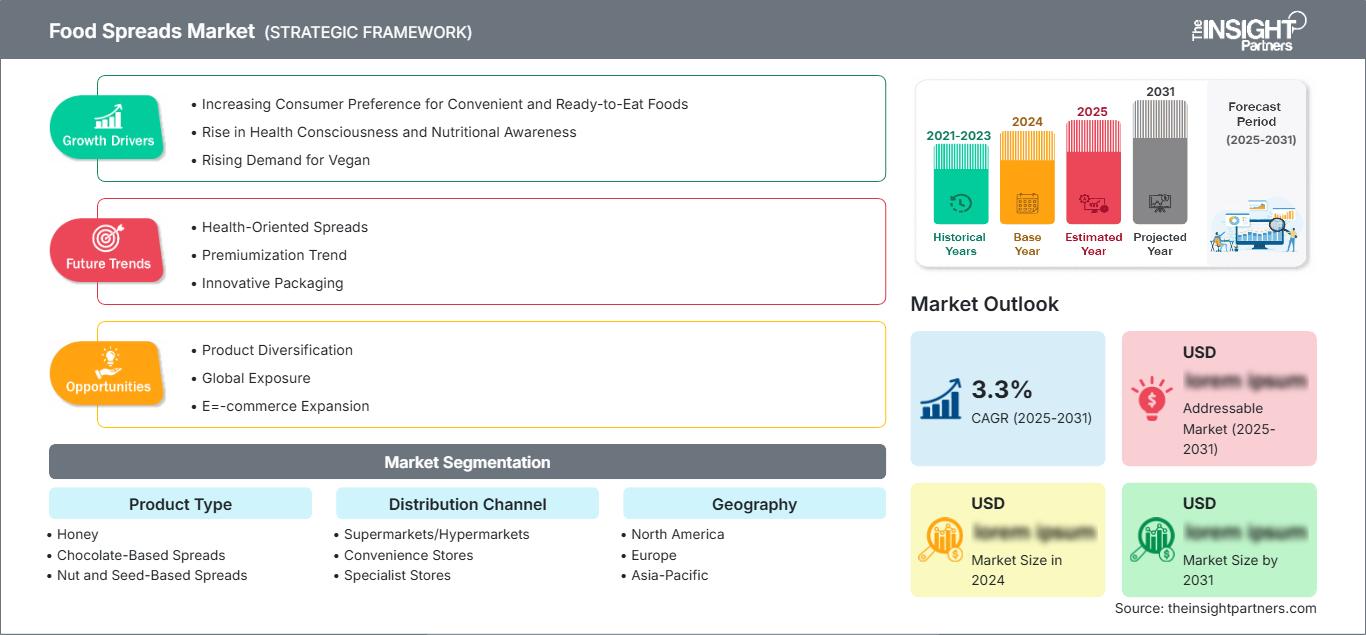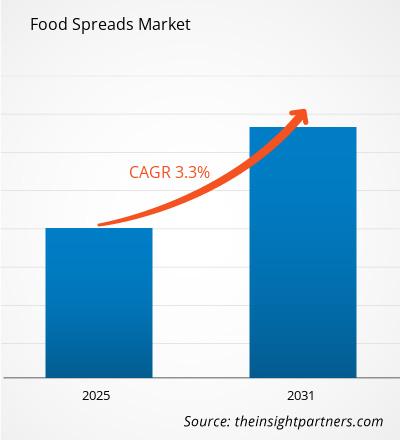Se prevé que el mercado de cremas para untar registre una tasa de crecimiento anual compuesta (TCAC) del 3,3% entre 2025 y 2031, con un tamaño de mercado que se expandirá de XX millones de dólares estadounidenses en 2024 a XX millones de dólares estadounidenses en 2031.
El informe sobre el mercado de cremas para untar incluye un análisis por tipo de producto (miel, cremas de chocolate, cremas de frutos secos y semillas, cremas de frutas y otras); canal de distribución (supermercados/hipermercados, tiendas de conveniencia, tiendas especializadas, tiendas online y otros) y geografía (Norteamérica, Europa, Asia Pacífico y Sudamérica y Centroamérica). El análisis global se desglosa además por regiones y países principales. El informe presenta el valor en USD para los análisis y segmentos mencionados.
Finalidad del informe
El informe sobre el mercado de cremas para untar, elaborado por The Insight Partners, tiene como objetivo describir el panorama actual y el crecimiento futuro, los principales factores impulsores, los desafíos y las oportunidades. Esto proporcionará información valiosa a diversos actores del sector, tales como:
- Proveedores/fabricantes de tecnología: Para comprender la evolución de la dinámica del mercado y conocer las posibles oportunidades de crecimiento, lo que les permitirá tomar decisiones estratégicas informadas.
- Inversores: Realizar un análisis exhaustivo de las tendencias relativas a la tasa de crecimiento del mercado, las proyecciones financieras del mercado y las oportunidades que existen a lo largo de la cadena de valor.
- Organismos reguladores: Regular las políticas y controlar las actividades en el mercado con el objetivo de minimizar los abusos, preservar la confianza de los inversores y mantener la integridad y la estabilidad del mercado.
Segmentación del mercado de cremas para untar
Tipo de producto
- Miel
- Cremas para untar a base de chocolate
- Cremas para untar a base de frutos secos y semillas
- Untables a base de frutas
- Otros
Canal de distribución
- Supermercados/Hipermercados
- Tiendas de conveniencia
- Tiendas especializadas
- Tiendas minoristas en línea
Obtendrá personalización gratuita de cualquier informe, incluyendo partes de este informe, análisis a nivel de país y paquetes de datos de Excel. Además, podrá aprovechar excelentes ofertas y descuentos para empresas emergentes y universidades.
Mercado de cremas para untar: Perspectivas estratégicas

-
Obtenga las principales tendencias clave del mercado que se describen en este informe.Esta muestra GRATUITA incluirá análisis de datos, que abarcarán desde tendencias de mercado hasta estimaciones y pronósticos.
Factores que impulsan el crecimiento del mercado de cremas para untar
- La creciente preferencia de los consumidores por alimentos prácticos y listos para consumir: Según informes de mercado, la importancia cada vez mayor del desayuno en la rutina diaria impulsa la demanda de productos para untar como la mantequilla y las mermeladas. Esta tendencia genera un crecimiento sustancial del mercado a nivel mundial.
- Mayor conciencia sobre la salud y la nutrición: La introducción de margarinas orgánicas, bajas en azúcar y enriquecidas satisface las necesidades de los consumidores preocupados por su salud, lo que mejora la competitividad del mercado. El análisis de mercado refleja estos cambios en las preferencias de los consumidores.
- Aumento de la demanda de productos veganos: La demanda de cremas para untar veganas, como las de almendra y aguacate, contribuye al crecimiento del mercado. El análisis de la competencia revela una tendencia hacia la innovación en productos de origen vegetal.
Tendencias futuras del mercado de cremas para untar
- Cremas para untar saludables: Las cremas para untar a base de frutos secos y bajas en azúcar están dominando el mercado, lo que está cambiando la dinámica del mismo, ya que los consumidores demandan opciones funcionales y naturales.
- Tendencia de premiumización: Las cremas para untar de alta gama con sabores exóticos y certificaciones orgánicas son estrategias de mercado nicho.
- Envases innovadores: Los diseños prácticos, ecológicos y resellables atraen a los consumidores modernos y aumentan la diferenciación de la marca.
Oportunidades de mercado para cremas para untar
- Diversificación de productos: Ante la creciente demanda de los consumidores por alternativas más saludables a la mantequilla y las cremas para untar tradicionales, el mercado de cremas para untar está experimentando un crecimiento en las opciones de origen vegetal, bajas en azúcar y enriquecidas con nutrientes. Esta tendencia representa una importante oportunidad para que las empresas innoven y consigan una mayor cuota de los mercados norteamericano y europeo.
- Exposición global: Con el creciente interés por los sabores internacionales, aumenta la demanda de cremas para untar exóticas y de alta calidad. Los fabricantes pueden aprovechar esta oportunidad de crecimiento ofreciendo cremas gourmet únicas en mercados emergentes y nichos de mercado, obteniendo así una ventaja competitiva.
- Expansión del comercio electrónico: Una plataforma de venta online está transformando el mercado de cremas para untar, abriendo un nuevo canal de distribución. El comercio electrónico ofrece a las marcas la oportunidad de llegar a un público más amplio, especialmente en Norteamérica y Europa. La compra de alimentos online está ganando terreno en estas regiones, brindando oportunidades a las marcas.
Perspectivas regionales del mercado de cremas para untar
Los analistas de The Insight Partners han explicado en detalle las tendencias regionales y los factores que influyen en el mercado de cremas para untar durante el período de previsión. Esta sección también analiza los segmentos del mercado de cremas para untar y su distribución geográfica en Norteamérica, Europa, Asia Pacífico, Oriente Medio y África, y Sudamérica y Centroamérica.
Alcance del informe de mercado de cremas para untar
| Atributo del informe | Detalles |
|---|---|
| Tamaño del mercado en 2024 | XX millones de dólares estadounidenses |
| Tamaño del mercado para 2031 | XX millones de dólares estadounidenses |
| Tasa de crecimiento anual compuesto global (2025 - 2031) | 3,3% |
| Datos históricos | 2021-2023 |
| período de previsión | 2025-2031 |
| Segmentos cubiertos |
Por tipo de producto
|
| Regiones y países cubiertos |
América del norte
|
| Líderes del mercado y perfiles de empresas clave |
|
Densidad de los participantes en el mercado de productos para untar: comprensión de su impacto en la dinámica empresarial.
El mercado de cremas para untar está creciendo rápidamente, impulsado por la creciente demanda de los consumidores finales debido a factores como la evolución de las preferencias de los consumidores, los avances tecnológicos y una mayor conciencia de los beneficios del producto. A medida que aumenta la demanda, las empresas amplían su oferta, innovan para satisfacer las necesidades de los consumidores y aprovechan las nuevas tendencias, lo que impulsa aún más el crecimiento del mercado.

- Obtenga una visión general de los principales actores del mercado de cremas para untar
Puntos clave de venta
- Cobertura integral: El informe abarca de forma exhaustiva el análisis de productos, servicios, tipos y usuarios finales del mercado de cremas para untar, proporcionando una visión holística.
- Análisis de expertos: El informe se elabora a partir del profundo conocimiento de expertos y analistas del sector.
- Información actualizada: El informe garantiza su relevancia para el negocio gracias a su cobertura de información reciente y tendencias de datos.
- Opciones de personalización: Este informe se puede personalizar para satisfacer las necesidades específicas del cliente y adaptarse adecuadamente a las estrategias comerciales.
Por lo tanto, el informe de investigación sobre el mercado de cremas para untar puede ayudar a impulsar la comprensión del panorama del sector y sus perspectivas de crecimiento. Si bien existen algunas preocupaciones válidas, los beneficios generales de este informe tienden a superar las desventajas.
- Análisis histórico (2 años), año base, pronóstico (7 años) con CAGR
- Análisis PEST y FODA
- Tamaño del mercado, valor/volumen: global, regional y nacional
- Industria y panorama competitivo
- Conjunto de datos de Excel
Informes recientes
Informes relacionados
Testimonios
Razón para comprar
- Toma de decisiones informada
- Comprensión de la dinámica del mercado
- Análisis competitivo
- Información sobre clientes
- Pronósticos del mercado
- Mitigación de riesgos
- Planificación estratégica
- Justificación de la inversión
- Identificación de mercados emergentes
- Mejora de las estrategias de marketing
- Impulso de la eficiencia operativa
- Alineación con las tendencias regulatorias






















 Obtenga una muestra gratuita para - Mercado de alimentos para untar
Obtenga una muestra gratuita para - Mercado de alimentos para untar